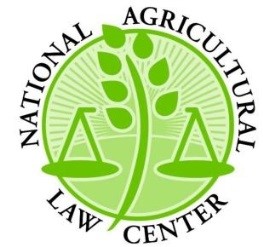A comprehensive summary of today’s judicial, legislative, and regulatory developments in agriculture and food. Email important additions HERE.
ANNOUNCEMENT: Join us tomorrow at 12 noon (ET) for an Agricultural & Food Law Consortium webinar: “Understanding the H-2A Temporary Agricultural Guest Worker Program.” Details available here.
JUDICIAL: Includes CAA, animal ID, agritourism and nutrition programs issues.
In BROWN-FORMAN CORPORATION and Heaven Hill Distilleries, Inc., Appellants v. George MILLER, Appellee, 2014-SC-000717-DG, 2017 WL 4296968 (Ky. September 28, 2017), a property owner sued neighboring distilleries for negligence, claiming ethanol emissions from their bourbon aging process caused growth of whiskey fungus on his property. Lower court ruled the Clean Air Act (CAA) preempted owner’s state law claims and dismissed, and owner appealed. Court of Appeals reversed and distillery appealed. Kentucky Supreme Court found that the CAA “did not preempt property owner’s state tort claims,” but that owner was not entitled to injunctive relief.
In GREGORY JOHNSON and BEAR MOUNTAIN, L.L.C., Plaintiffs/Counter-Defendants-Appellants, and CENTER FOR FOOD SAFETY, Amicus Curiae, v. DEPARTMENT OF NATURAL RESOURCES and DIRECTOR, DEPARTMENT OF NATURAL RESOURCES, Defendants/Counter-Plaintiffs-Appellees, No. 335645, 2017 WL 4555271 (Mich. Ct. App. October 12, 2017), trial court determined that 10 of plaintiff’s pigs violated the defendant’s Invasive Species Order Amendment after finding some of plaintiff’s animals were prohibited “as sus scrofa or hybrids thereof.” Court found that the animals at issue were the result of a “domestic breeding process and that the ‘Hogan Hog’ was derived from a mix of four known and registered breeds of sus domestica . . . but then looked to phenotype identification.” Plaintiff argued court erred in finding that “two animals could procreate to produce an illegal animal.” Appellate court affirmed ruling, noting that trial court “correctly recognized that phenotyping was the only way to characterize the animals.”
In Neill FISHMAN, Plaintiff and Appellant, v. GRBR, INC., and Does 1-5, Defendant and Appellee, DA 17-0214, 2017 WL 4415795 (Mont. October 5, 2017), plaintiff was injured after falling off a horse during a trail ride operated by defendant and sued for negligence. Trial court found for defendant, observing that “among the risks inherent to equine activities is the risk that saddle girths may loosen during a ride and cause slippage of the saddle, which may result in a fall.” Issue was whether defendant was exempted from liability under the state’s Equine Activities Act, which states that “a person is not liable for damages sustained by another solely as the result of risks inherent in equine activities if those risks are or should be reasonably obvious, expected, or necessary to persons engaged in equine activities.” Appellate court found trial court’s ruling “was premised upon the circumstances of this accident coming within the inherent risks of equine activity as defined in the Equine Act, and not within the statute’s exception to that liability limitation.” Affirmed for defendant.
In STATE OF OHIO PLAINTIFF-APPELLEE v. LAKETTA AGEE DEFENDANT-APPELLANT, No. 104915, 2017 WL 4548330 (Ohio Ct. App. October 12, 2017), defendant appealed convictions for two felonies involving “illegal possession of food stamps secured by falsifying reporting documents.” State argued defendant did not report self-employment income and falsified documents based on the “knowing omission” of self-employment income. Appellate court noted that state only provided one witness and it was their own investigator. Court also noted that state failed to demonstrate that defendant’s execution of her financial reports was “knowing and with a purpose to defraud.” Reversed for defendant.
REGULATORY: Includes ARS, EPA, NASS, and NOAA rules and notices.
AGRICULTURAL RESEARCH SERVICE: Notice ARS will grant to the CALIFORNIA TABLE GRAPE COMMISSION of FRESNO, CALIFORNIA, an exclusive license to the variety of table grape described in U.S. Plant Patent Application Serial No. 15/731,420, “GRAPEVINE NAMED `SOLBRIO,’ ” filed on JUNE 6, 2017. Details here.
ENVIRONMENTAL PROTECTION AGENCY:
Rule EPA is finalizing a partial approval of the 2009 Texas Regional Haze State Implementation Plan (SIP) submission and a Federal Implementation Plan (FIP) for Texas to address certain outstanding requirements. Info here.
Rule EPA sent the State of Vermont a letter approving Vermont’s request for partial delegation of the New Source Performance Standards for New Residential Wood Heaters, New Residential Hydronic Heaters, and Forced-Air Furnaces. Info here.
NATIONAL AGRICULTURAL STATISTICS SERVICE: Notice NASS announces a meeting of the Advisory Committee on Agriculture Statistics. Info here.
NATIONAL OCEANIC AND ATMOSPHERIC ADMINISTRATION:
Rule NMFS is prohibiting retention of sablefish by vessels using trawl gear and not participating in the cooperative fishery of the Rockfish Program in the Central Regulatory Area of the Gulf of Alaska. Info here.
Notice the Department of Commerce will submit to the Office of Management and Budget (OMB) for clearance the following proposal for collection of information under the provisions of the Paperwork Reduction Act. Title: Groundfish Trawl Catcher Processor Economic Data Report. Details here.
Notice the Department of Commerce will submit to the Office of Management and Budget (OMB) for clearance the following proposal for collection of information under the provisions of the Paperwork Reduction Act. Title: Highly Migratory Species Vessel Logbooks and Cost-Earnings Data Reports. Info here.
Notice NMFS informs surfclam and ocean quahog individual transferable quota (ITQ) allocation holders that they will be required to purchase their fishing year 2018 (January 1, 2018-December 31, 2018) cage tags from the National Band and Tag Company. Details here.
